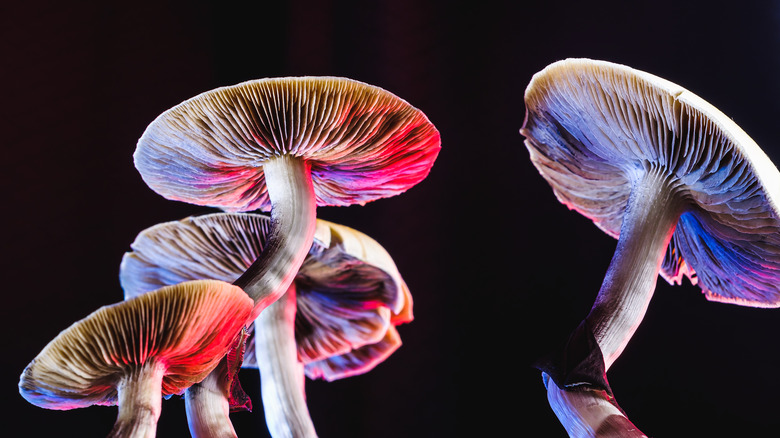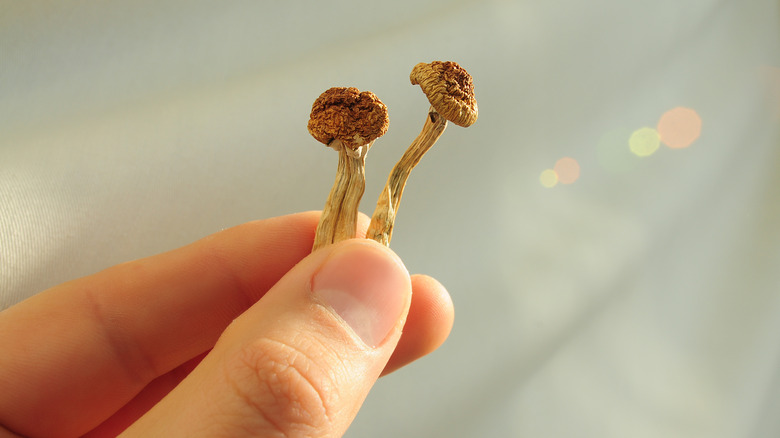The Health Benefits Of Mushroom Stacking
These days, conversations about mushrooms are rarely focused on your average shiitake and portobello. Medicinal mushrooms are super buzzy, and not just among hippies and stoners. Metro reports that Meghan Markle and Oprah are among shrooms' famous fans. And globally, the medicinal mushroom market is taking off, according to a report from Data Bridge Market Research.
Even if they're having a moment, fungi aren't exactly a new discovery. In fact, therapeutic mushrooms have been used in Chinese medicine for centuries. These days, however, more people are becoming aware of the potential benefits of mushrooms. For example, reishi mushrooms have been found to boost immunity, fight certain types of cancer, and relieve symptoms of anxiety and depression. A 2022 study published in Nature-Scientific Reports also discovered that those who microdosed psilocybin (an illegal compound found in magic mushrooms) noticed long-term improvements in mood.
One trendy way to reap the purported benefits is by mushroom stacking. Here's why microdosers recommend the trend and how to create your own stack.
What is mushroom stacking?
Though mushroom stacking may sound like a strange party game, it's actually a method of microdosing made popular by mycologist Paul Stamets. In a "stack," a microdose of medicinal mushrooms is combined with other substances that are thought to offer additional physical and mental health benefits. According to the Microdosing Institute, Stamets' go-to stack includes the mushroom Lion's Mane, niacin, and the mushroom compound psilocybin.
Mushroom newbies may enjoy experimenting with a variety of adaptogens and antioxidants, though those already familiar with different types of fungi can also try stacking multiple types of mushrooms. Reishi, Turkey Tail, Chaga, Cordyceps, and Lion's Mane are among the medicinal mushrooms that can be mixed and matched within one stack.
Mushroom stacking can also include ingredients you likely already have in your kitchen. Before Stamets created his famous stack, the Aztecs combined psilocybin mushrooms with liquid cacao. Additionally, mushroom coffee, where medicinal mushrooms are ground into coffee beans, is a trendy and convenient way to try stacking.
How stacking may affect your health
Microdosing mushrooms, and using psilocybin in particular, may not be totally mainstream (or legal) just yet, but research is beginning to uncover promising health benefits. "The data are strong from depression to PTSD to cluster headaches, which is one of the most painful conditions I'm aware of," Richard Isaacson, a neurologist, explained to CNN. However, as Truffle Report notes, there still aren't many studies available on the effects of stacking mushrooms.
For now, microdosing enthusiasts are combining mushrooms and other ingredients almost as a form of alternative medicine, varying the formula based on their personal needs and preferences. For example, the "Stamets Stack" is believed to boost cognition and create new neurons in the brain, according to Health News. Other stacks are chosen based on their purported ability to improve creativity, learning, or mood.
Even if stacking may offer some physical and mental health benefits, it may not be right for everyone, especially if it's done using psychedelic mushrooms. Experts told CNN that the method isn't suitable for people with bipolar disorder, schizophrenia, or those who experience psychosis. Moreover, some substances used in microdosing and stacking could trigger side effects such as high blood pressure, fever, and vomiting.


